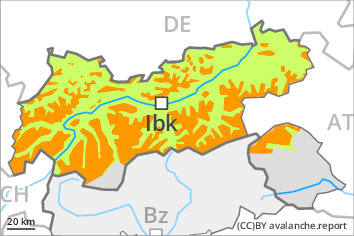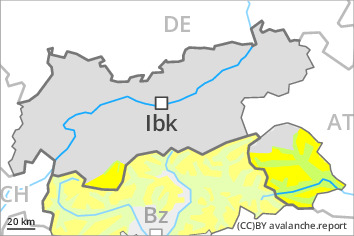
Danger level
 | treeline |
|  |
|  | ||||
|  |
|  |

Wind slabs represent the main danger.
The fresh and somewhat older wind slabs are lying on the unfavourable surface of an old snowpack. These can be released by a single winter sport participant above the tree line. This also applies in areas close to the tree line. The wind slabs are covered with new snow in some cases and therefore difficult to recognise. They are to be avoided as far as possible. The avalanche prone locations are to be found in particular in gullies and bowls in all aspects, but in isolated cases also adjacent to ridgelines. Avalanches are medium-sized. Restraint should be exercised because avalanches can sweep people along and give rise to falls.
Low and intermediate altitudes: Individual moist loose snow avalanches are possible, but they will be mostly small.
In addition further individual gliding avalanches are possible, in particular on steep east, south and west facing slopes below approximately 2600 m. In isolated cases the gliding avalanches are quite large, in particular in the regions with a lot of snow. Areas with glide cracks are to be avoided.
Snowpack
dp.6: cold, loose snow and wind
5 to 15 cm of snow, and up to 20 cm in some localities, has fallen. As a consequence of new snow and a strong wind from westerly directions, further wind slabs formed in the last few days in particular in gullies and bowls and behind abrupt changes in the terrain. The sometimes new snow-covered wind slabs are lying on the unfavourable surface of an old snowpack. They are rather small but prone to triggering.
Towards its base, the snowpack is largely stable. Snow depths vary greatly above the tree line, depending on the infuence of the wind. The snowpack will be subject to considerable local variations. The rain gave rise to significant moistening of the snowpack in particular at low and intermediate altitudes.
Tendency
The fresh wind slabs are bonding only slowly with the old snowpack. Slight decrease in danger of dry avalanches.



